“Grandpa’s Book” Part 1

Most people in my family know that our grandfather, Emil Johnson, was a band corporal during World War 1, and that based on his letters, he was a prolific writer. Perhaps as a result of having been a reporter for the Ludington Daily News as a young man, he most often typed his letters, single spaced, and usually saved a carbon copy. Or maybe it was because his father, Nels, wrote the same way. (See “Letters to Emil, Part 1” for an example of this.)
Many of his writings have found their way to me, including the original manuscript and a bound copy of a book he wrote toward the end of his life. A memoir of the first world war, entitled “The Forgotten Bandsmen,” the book details his experience as an army band corporal both during training and overseas. It is usually referred to (at least by me) as “Grandpa’s Book”.
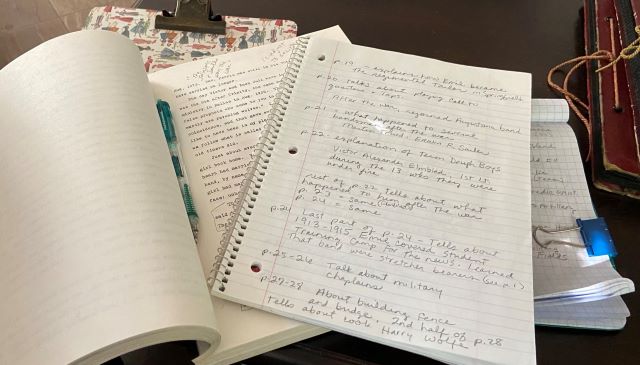
For the past couple of months I’ve been working on putting the events from the book into chronological order. It was originally written in sort of a “stream of consciousness” style, with regular switches between stories of training, the war itself, college and high school days, and what happened to the men of the 123rd after the war. I think it’s fantastic that he would have written all this while in his eighties, and I’m not criticizing by any stretch of the imagination. But for someone like me, in order to fully appreciate the story, I had to see the events chronologically.
First I went through each page and wrote down a brief description of what was there. Then I decided to color code my notebook, so that I could tell at a glance where the different events fit in. Now I can cross reference between the book and my notes for ease in organizing.
Emil’s history with the military actually dates back to several years before he joined the Army. In 1913-1915 he worked (in his words) as a “cub reporter” for the Ludington Daily News. One of his jobs was to cover the nearby Lincoln Fields military training camp each summer. It was here that he learned that Army bands were designated as stretcher bearers. “I learned that members of an infantry band were stretcher bearers in action. I made this very clear when members of the college band were considering enlisting in the 6th Illinois Infantry. Twenty-one members enlisted in Rock Island. We fully intended to be stretcher bearers and give first aid to the wounded, We went in for the duration to save lives, and not to kill.”

Emil mentioned having covered an accidental drowning at Lincoln Fields. I knew it had to be from the summer of either 1913, 1914, or 1915. Thanks to the Google news archives, I was able to find the article he wrote, and then I searched the victim’s name on Ancestry.com and found the death certificate. The book, some 60 years later, states that two students drowned; however in Emil’s news article we find that one of them was in fact rescued. While it isn’t mentioned in the article, he later wrote, “The commanding officer assured me, that while this tragedy was deeply regretted, the training must continue.”
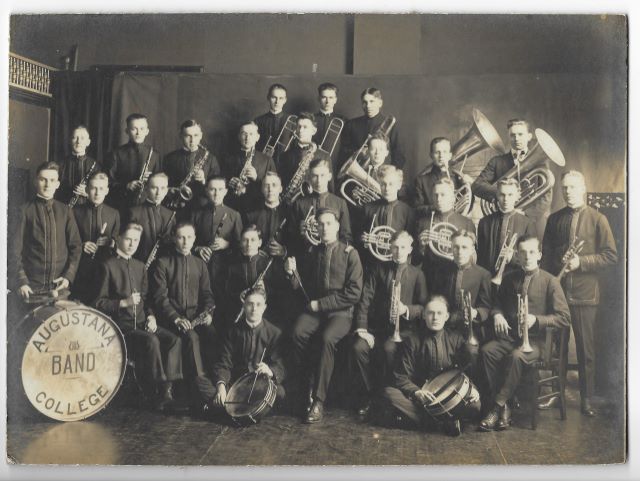
This is the Augustana College band, as it appeared on page 148 of the 1916 Augustana yearbook. Click here to see the actual yearbook page. If you count everyone seated as Row 1, Emil is third from the right in Row 2. Most of the band members would soon enlist in the Illinois National Guard.
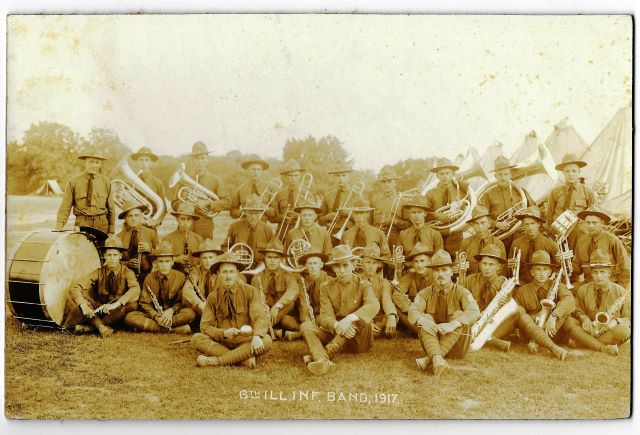

Fast forward to 1917, and here is the 6th Illinois Infantry Band, made up largely of the aforementioned Augustana College band. There were doubtless some band members already there, plus there were a few draftees, two of whom were Frank Vasco and Joe Two Eagle. (Remember those names for a future post.) That’s Emil in the middle row, third from the left.
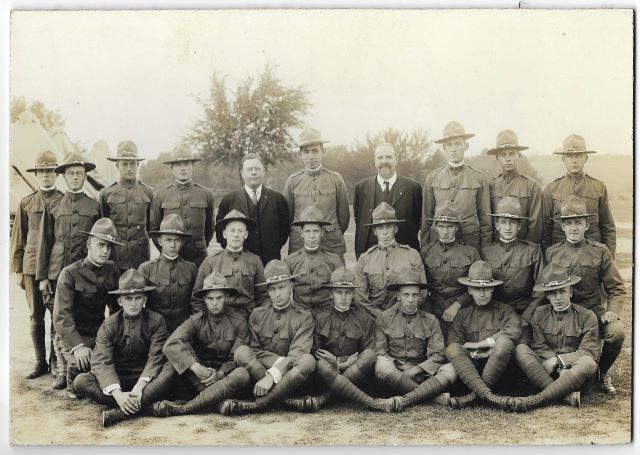
The back of this photo says “Camp Lowden, August 31, 1917”. I don’t know who the men in suits were. Can you find Emil?

I had wondered what was going on in this photo, since I couldn’t see any musical instruments besides the drum. I found the answer on page 7 of Grandpa’s book. “Major Dr. H.H. Tuttle, of Springfield, met with us 2 or 3 hours each morning, to instruct us in First Aid, and prepare us to be stretcher bearers. He was also the Post Doctor, and he looked like one, with a graying goatee. Dr. Tuttle sat in a chair. We sat on terra firma, that is, when the weather permitted.” He went on to describe practice battles where some men were the “victims” and the others put them on stretchers and bandaged them based on the “wounds” they had received. “We were taught how to make tourniquets to prevent the loss of too much blood. We also learned how to make splints with most any kind of material.”

In September of 1917 the 6th Illinois Infantry left Springfield, Illinois for Camp Logan in Houston, Texas. Immediately after their arrival they were converted into the 123rd Field Artillery. The story of why this happened is interesting, but to keep this from getting too long I’ll to explain it in a later post. (For relatives with a copy of the book, it’s on page 45.) They continued their training in Houston until May of 1918, when they boarded the SS Scotian for Brest, France.
The 1918 edition of the Augustana College yearbook features several pages dedicated to those who served in the armed forces during the war. I have interesting stories to tell you about the ones marked “in Emil’s book”, both from their training and while they were overseas in France. But that will have to wait for “Part 2”.

Meanwhile, my trusty assistant and I will be taking more notes and looking up more information.







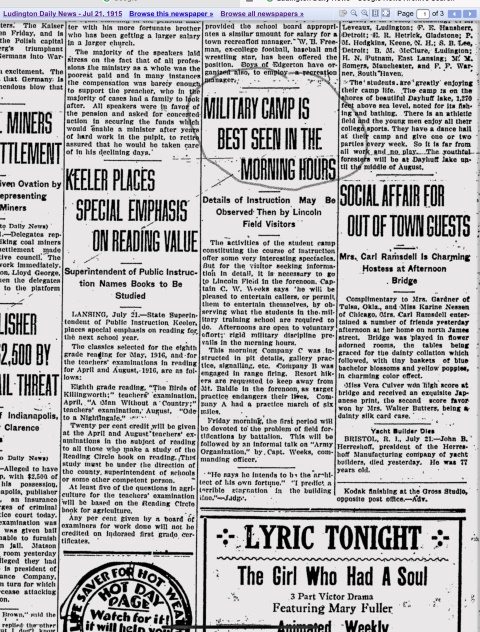


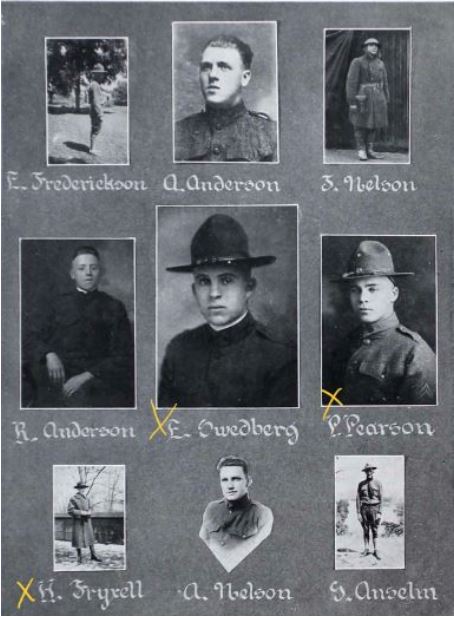
WOW – this is so cool to have all of this history!!! Thank you for sharing, and I can’t wait for Pt. 2
Thank you! I’m glad you liked it. 😊
Your posts always amaze me!
Thanks, Yari! I’m glad you enjoy them. 😂
What fun (and a lot of work too!) to piece all this history together! A family treasure! 🙂
Thanks! Yes I always did like history, and I’m amazed at how much I didn’t know🧐
This is fascinating, Debra… so much hard work and so much to look forward to. Can’t wait for the next installment!
Actually, neither can I! 😂
That is so interesting and I know it is enjoyable research for you. Foster looks a bit surprised at all the amazing information you are uncovering, I hope you have a wonderful weekend,
Thanks Sandra! You too😀
Charlee: “It’s so cool that you have all those photos and that history to read and look back on.”
Chaplin: “Good job supervising the project, Foster!”
Foster: Thanks, guys! I am very diligent about getting in every box of family history stuff and I even help mom pick out photos by ruffling through them with my paws.👍😀